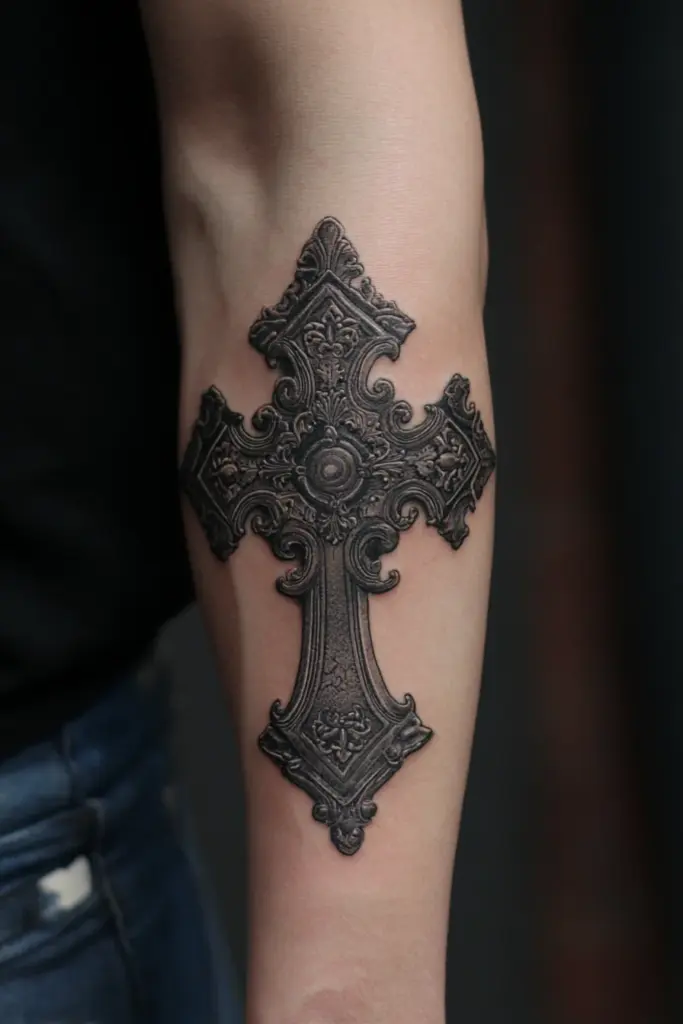I’m Hakan, a tattoo consultant and designer with over 10 years working directly with clients on modern, meaningful ink. Cross tattoos for men remain one of the most versatile choices — they can express faith, memorialize a loved one, anchor a personal philosophy, or simply act as a strong visual element. In my experience, the best cross tattoos blend clear symbolism with design choices that suit body shape, lifestyle and skin tone. This post is for men who want a thoughtful piece: from bold chest statements and forearm blackwork to subtle wrist or behind-the-ear marks. Practical tips I recommend: decide style first (Celtic, Latin, minimalist, realistic), test size with temporary transfers, consider contrast for darker skin, and plan placement around muscle and movement. Always book a consultation to refine line weight, shading and aftercare so your cross ages cleanly.
Ornate Gothic Cross Tattoo — Upper Arm Black & Grey Christian Design
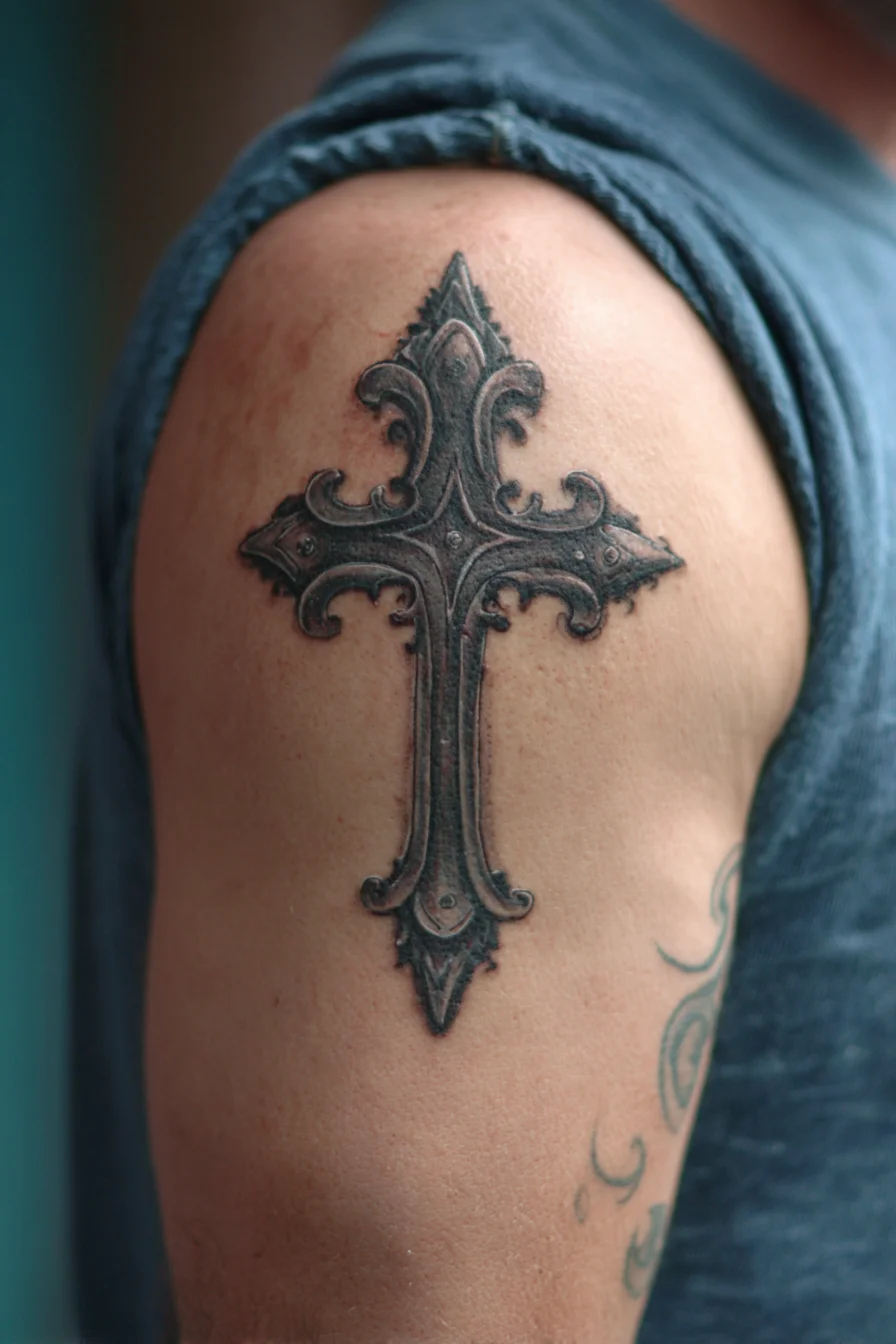
This ornate Gothic cross blends religious symbolism with a sculpted, metallic look — ideal for men seeking a bold, meaningful piece that reads both as faith and personal heritage. The layered scrollwork and graywash shading create depth and an antique, three-dimensional effect often chosen for memorial or protection-themed tattoos. Placement suggestions: the outer upper arm or shoulder (as pictured) suits this shape well, offering visibility and easy concealment with short sleeves. Other options include the chest, sternum, or centered on the back for a larger statement. Pain expectations: outer upper arm is low-to-moderate on most men; expect increased sensitivity closer to bone (shoulder cap, sternum, ribs). Size considerations: keep this design mid-size (about 4–6 inches) to preserve intricate filigree; shrink it much smaller and fine details will blur over time, while enlarging allows richer texture and realism. Styling variations: black-and-grey graywash, heavier blackline silhouette, added color accents (deep reds or golds), dotwork backgrounds, or integrating banners, names, or rosary beads. Discuss line weight, contrast, and touch-up plans with your artist to ensure longevity and the look you want.
Ornate Filigree Cross Tattoo — Forearm Black & Grey Design
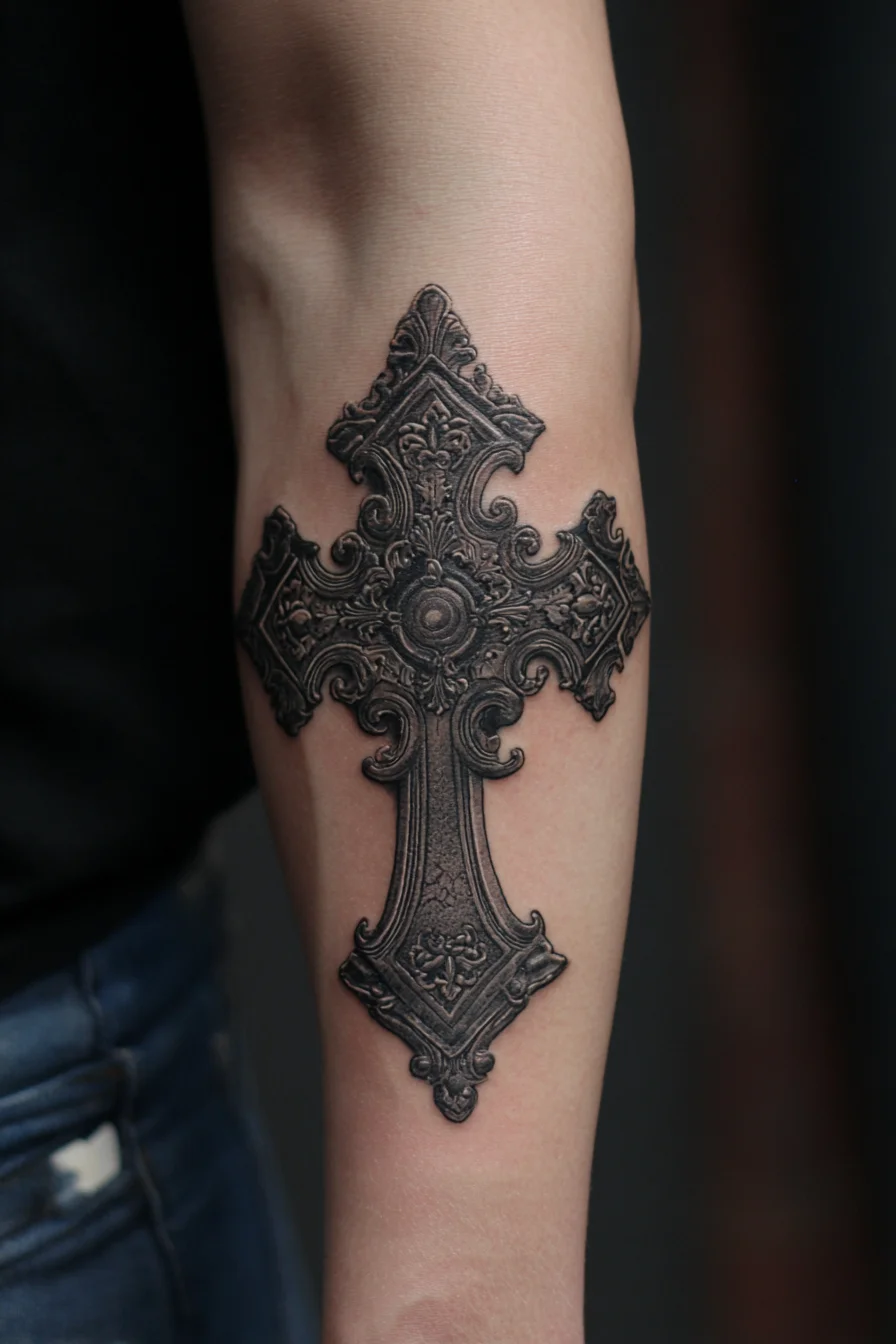
This ornate filigree cross combines classic Christian symbolism with baroque ornamentation, offering a strong statement of faith, heritage or protection. The dense, textured detail mimics carved metalwork and reads as an heirloom piece—ideal for someone who wants a bold, meaningful focal tattoo. Placement suggestions: the inner or outer forearm (as shown) provides visibility and a flat canvas; other good masculine placements include the chest, upper arm/bicep, shoulder blade, or calf for a larger piece. Pain expectations: forearm locations are typically low-to-moderate in pain; expect more sensitivity near the inner elbow, wrist, or sternum, while the bicep and outer shoulder are generally milder. Size considerations: to retain the fine filigree, opt for medium to large scale (roughly 4–7 inches / 10–18 cm) so lines and shading don’t blur with time; if you prefer a smaller version, simplify details and use bolder line work. Styling variations: black-and-grey realism, heavy blackwork for a masculine read, dotwork shading, subtle color washes (bronze or muted reds), or integrating script, rosary beads, or a background halo to personalize the piece.
Dotwork Cross Forearm Tattoo — Masculine Religious Cross Design
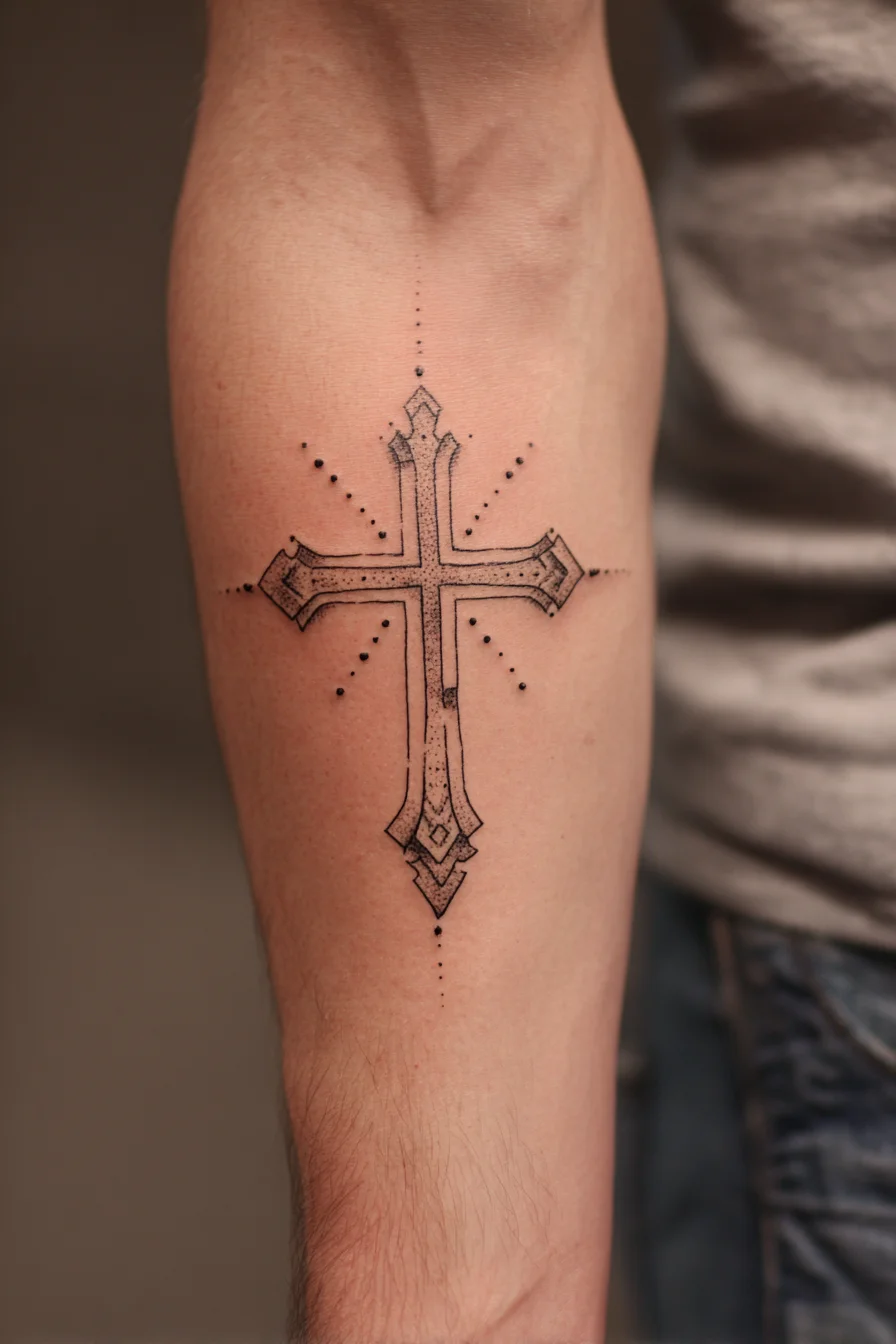
A refined dotwork cross like this reads as a classic faith symbol with a modern, masculine edge. The layered linework and stippling suggest protection, resilience, and personal conviction while remaining stylistically versatile — suitable for religious or secular meanings depending on personal context. Placement suggestions: inner forearm for visibility and lower pain, outer forearm or bicep for a more public display, chest or upper back if you want a larger, more private statement. Pain level expectations: inner and outer forearm generally register low to moderate discomfort; expect sharper sensitivity near the wrist, elbow crease, and bony areas. Size considerations: keep fine-line and dotwork details at least 2.5–3 in (6–8 cm) tall to preserve clarity; medium (4–6 in / 10–15 cm) works well for visible forearm pieces, while larger scales allow for extra ornamentation. Styling variations: solid black silhouette, dense dot shading, ornamental filigree or gothic flourishes, subtle color washes, or integrating a rosary, name, or geometric background. Consult your artist about line thickness and dot density to ensure longevity and crisp healing.
Ornate Sword-Cross Forearm Tattoo — Medieval Blade & Cross (Black & Grey)
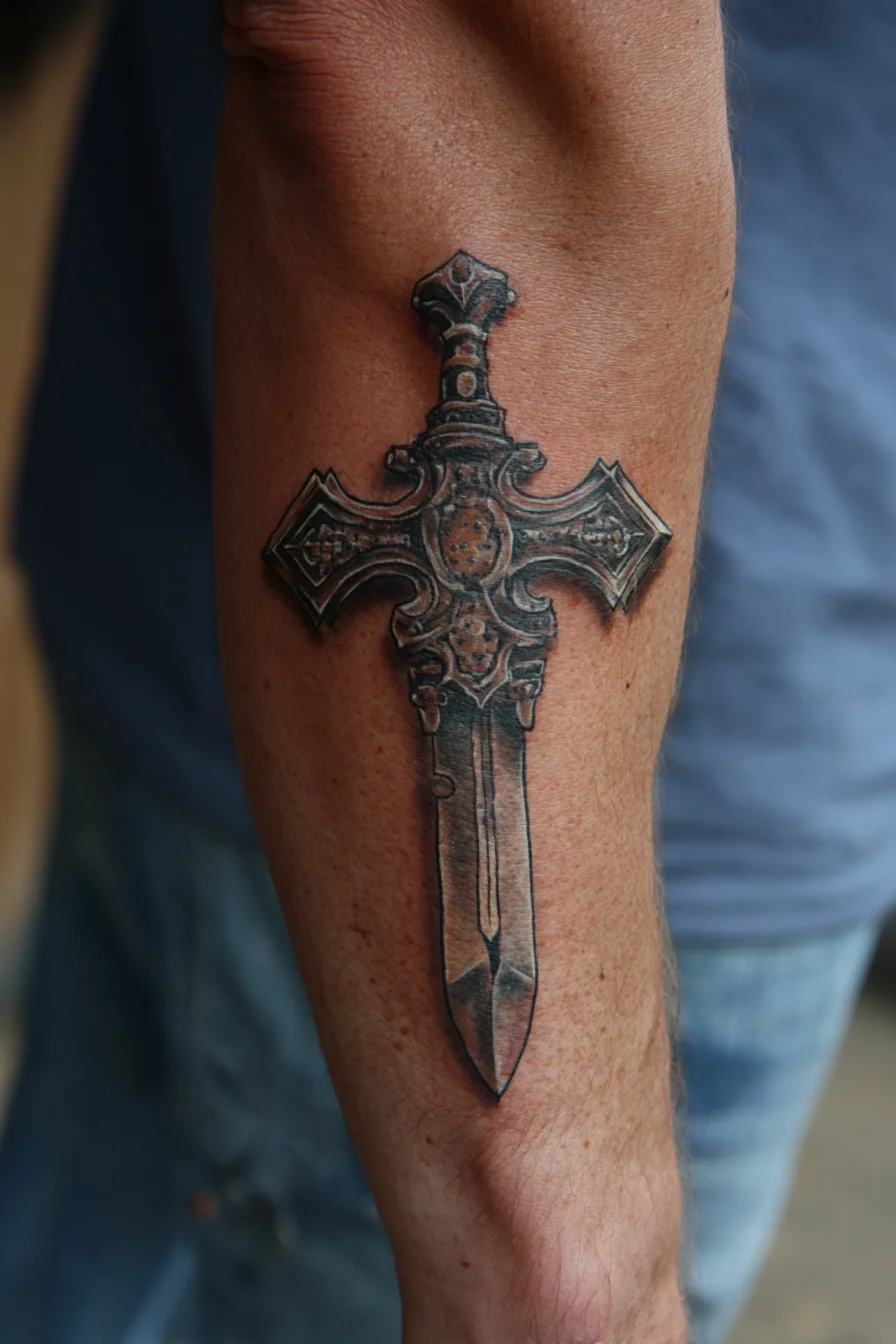
This ornate sword-cross design fuses medieval blade imagery with a cross-shaped guard, creating a masculine symbol of strength, protection and personal conviction. The detailed hilt and decorative elements allow for personalization—initials, family crests or subtle religious motifs—while keeping a rugged, timeless look. Placement suggestions: the inner forearm (as shown) is ideal for clear visibility, flat surface for fine linework and easy concealment with long sleeves; alternatives include outer forearm, upper arm, chest or calf depending on how public you want the piece. Pain expectations: inner forearm work is typically moderate—less painful than ribs or sternum but more sensitive near the wrist and elbow; expect brief discomfort around bony areas. Size considerations: preserve the vertical proportions of a sword by choosing a long, narrow layout; 4–8 inches suits most forearms, smaller sizes will sacrifice ornamental detail, larger pieces allow more texture and metallic highlights. Styling variations: classic black-and-grey realism, neo-traditional bold outlines, subtle color accents (bronze, rust or deep red), or background dotwork/filigree to integrate into a sleeve. Discuss needle selection, session time and aftercare with your artist to ensure crisp, lasting detail.
Vertical Sketch Cross Forearm Tattoo — Minimal Linework Religious Symbol
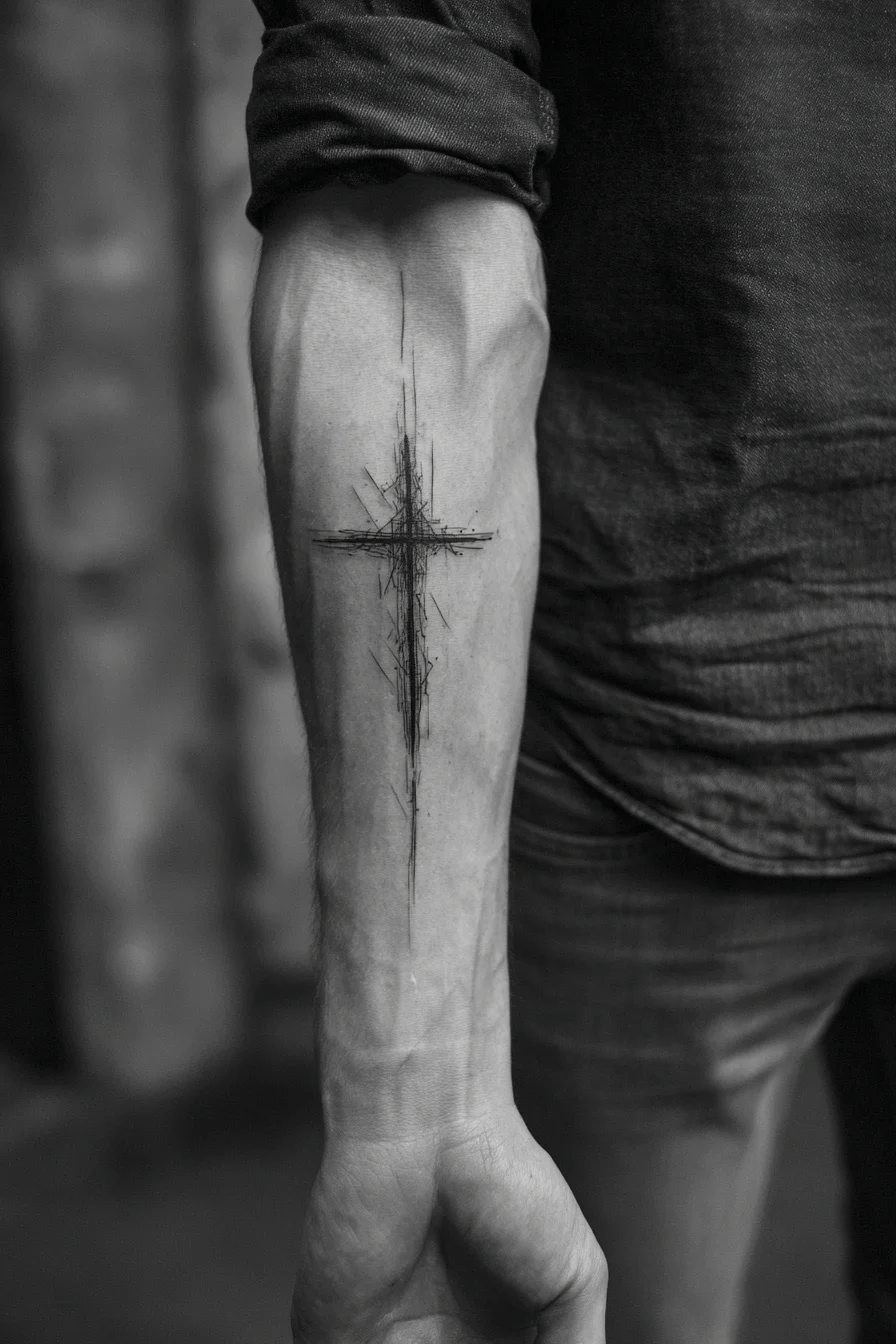
This vertical sketch-style cross is a minimalist, modern take on a classic Christian emblem, blending rough, hand-drawn lines with a long, elegant shaft. For men it often reads as a symbol of faith, resilience and understated conviction while maintaining a contemporary, artistic edge. Placement: the inner forearm shown is ideal — the vertical orientation follows natural muscle and vein lines and is easily visible or covered by sleeves. You can also consider the outer forearm, ribcage, upper arm or sternum for larger, statement versions. Pain expectations: inner forearm tattooing is generally low-to-moderate in discomfort; areas closer to the wrist and elbow are more sensitive and may sting more. Size considerations: for longevity and clarity keep the central shaft bold enough to avoid premature blur — a typical forearm piece works well at roughly 10–18 cm (4–7 in) long with mixed line weights. Styling variations: single-needle fine lines for a delicate sketch, heavier blackwork for contrast, dotwork shading, or a subtle watercolor wash behind the cross. Discuss line thickness and placement with an experienced artist to balance detail retention and long-term wear.
Botanical Geometric Forearm Tattoo — Minimal Mens Linework

This design blends crisp geometric lines with subtle botanical elements to convey balance, travel-ready confidence, and a quiet connection to nature—qualities many men seek in contemporary body art. The clean linework and negative space keep the piece masculine and versatile while the plant motifs add organic contrast, making it suitable for personal symbolism such as growth, resilience, or a love of the outdoors. Placement suggestions: inner or outer forearm for visibility and lower pain; upper arm or calf for a more discrete look; expand into a half-sleeve if you want a bolder statement. Pain expectations: forearm and calf are generally low-to-moderate, upper arm is mild, while ribs and sternum are significantly more painful—choose placement based on your tolerance. Size considerations: keep fine-detail pieces at least 3–5 cm wide to preserve crisp lines; medium pieces (8–15 cm) allow for shading and geometric interplay; larger sleeves enable extensive storytelling and layering. Styling variations: blackwork line, dotwork shading, bolder tribal-influenced outlines, or subtle watercolor fills for seasonal color. Discuss sizing and aftercare with your artist to ensure longevity and the look you want.
As a practitioner who has guided hundreds of clients, my core advice is simple: make the cross personal and practical. Start with the meaning you want to convey, choose a style that complements your anatomy, and pick a placement that matches your pain tolerance and daily life. Smaller, high-motion areas need simpler linework; larger chest or back pieces allow for ornamentation like Celtic knots or portrait integration. Prioritize an experienced artist who shows crisp linework and healed photos in their portfolio, and discuss inks, needle sizes, and touch-up expectations during consultation. Follow professional aftercare and schedule a follow-up check at 6–12 weeks. With the right planning, a cross tattoo becomes a timeless anchor—both visually and emotionally. If you’d like, I can review your concept and recommend placement and artists based on your region. — Hakan
